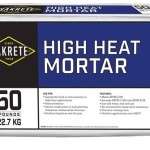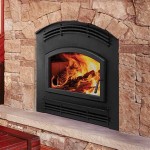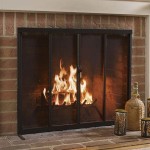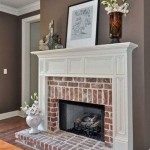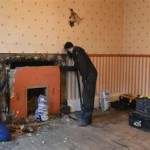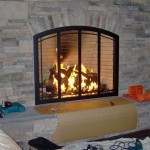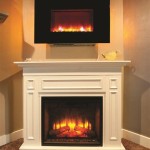Outdoor Brick Fireplace Design Plans: A Comprehensive Guide
An outdoor brick fireplace provides a focal point for outdoor living spaces, extending the use of patios and gardens throughout the year. Careful planning and consideration of design elements are crucial for a successful and aesthetically pleasing outcome. This article explores essential aspects of outdoor brick fireplace design plans, offering guidance on factors affecting the overall structure, functionality, and aesthetic appeal.
Site Selection and Regulations
Choosing the appropriate location for an outdoor brick fireplace is the first critical step. The location should consider prevailing winds, proximity to structures, and accessibility for construction and maintenance. Wind direction is vital because smoke drift can impact usability. Placing the fireplace upwind of seating areas or near windows of the house is generally not recommended. Furthermore, proximity to combustible materials, such as fences, wooden decks, or overhanging trees, requires careful evaluation to minimize the risk of fire.
Local building codes and regulations governing outdoor fireplaces must be strictly followed. These regulations often address setbacks from property lines, height limitations, chimney requirements, and permissible fuel types. Contacting the local building department before commencing any construction is essential to ensure compliance and avoid costly revisions later. Some jurisdictions may require permits for masonry structures, especially those involving fuel-burning appliances. Documents outlining the proposed design, materials, and compliance with relevant codes may be necessary for permit approval.
Adequate space for construction is another key site consideration. The area should accommodate not only the fireplace itself but also sufficient working space for masons and other tradespeople. Delivery of materials, such as bricks, mortar, and firebricks, requires accessible pathways and storage areas. Leveling the ground and preparing a stable foundation are fundamental steps before beginning the construction of the fireplace. The selected location should also allow for proper drainage to prevent water accumulation around the base of the structure, which could lead to deterioration over time.
Design Considerations and Material Selection
The design of an outdoor brick fireplace should harmoniously blend with the existing architectural style of the house and the overall landscape design. The size and shape of the fireplace should be proportionate to the size of the outdoor space. A large fireplace in a small yard may appear overwhelming, while a small fireplace in a large yard may lack visual impact. Consider the desired level of formality or informality when selecting the design. A rustic design with exposed brick and rough textures may be appropriate for a casual outdoor setting, while a more refined design with smooth surfaces and decorative elements may be suitable for a formal patio.
Brick is the primary material for constructing an outdoor fireplace, offering durability, heat resistance, and aesthetic versatility. Various types of brick are available, including common brick, face brick, and firebrick. Common brick is suitable for the main structure, while face brick can be used for the exterior finish to enhance the visual appeal. Firebrick, known for its ability to withstand high temperatures, is essential for lining the firebox, the area where the actual fire burns. The choice of brick color and texture significantly impacts the overall aesthetic of the fireplace. Matching the brick to the existing brick of the house or using contrasting colors for visual interest are common design strategies.
Mortar is the binding agent that holds the bricks together. The type of mortar used should be appropriate for outdoor applications and resistant to weathering and freeze-thaw cycles. Type S mortar is generally recommended for outdoor masonry projects due to its high compressive strength and good bonding properties. The color of the mortar can also affect the appearance of the fireplace. Matching the mortar color to the brick color creates a monolithic look, while contrasting mortar colors can accentuate the brick pattern. Consider using a tinted mortar to achieve the desired aesthetic effect.
Additional materials may include stone, concrete, and metal components. Stone can be incorporated into the design for decorative purposes, such as building a hearth or a chimney cap. Concrete is often used for the foundation of the fireplace and can be reinforced with rebar for added strength. Metal components, such as fire grates and chimney dampers, are necessary for the functionality of the fireplace. Selecting high-quality materials ensures the longevity and performance of the outdoor brick fireplace.
Structural Components and Construction Techniques
The foundation is the most critical structural component of an outdoor brick fireplace. A solid and level foundation is essential to prevent settling and cracking of the masonry structure. The foundation should extend below the frost line to prevent movement due to freezing and thawing of the ground. Concrete foundations should be reinforced with rebar and adequately cured before the construction of the fireplace begins. The size and depth of the foundation depend on the size and weight of the fireplace.
The firebox is the heart of the fireplace, where the fire burns. It should be constructed with firebrick, carefully laid in a refractory mortar. The firebox should be properly sized to provide adequate airflow and efficient combustion. A smoke chamber above the firebox directs the smoke into the chimney. The smoke chamber should be constructed with smooth, sloping walls to facilitate the upward flow of smoke. The design of the smoke chamber is crucial for preventing backdrafting and ensuring proper draft.
The chimney is responsible for venting the smoke and combustion gases away from the fireplace. The height of the chimney should be sufficient to create adequate draft and prevent smoke from blowing back into the seating area. Building codes typically specify minimum chimney heights based on the proximity to surrounding structures. The chimney should be constructed with a liner to protect the masonry from corrosive combustion products. Clay tile liners or stainless steel liners are commonly used. A chimney cap is essential to prevent rain and debris from entering the chimney.
Proper drainage is essential to prevent water damage to the fireplace. A weep hole should be provided at the base of the fireplace to allow water to escape. The area around the fireplace should be graded to direct water away from the structure. Consider installing a drainage system if the ground is prone to waterlogging.
Adhering to established masonry techniques is crucial for building a durable and aesthetically pleasing outdoor brick fireplace. Bricks should be laid in a running bond pattern, with staggered joints for added strength. Mortar joints should be neatly finished and tooled to create a watertight seal. Regularly check the level and plumb of the structure throughout the construction process. Proper curing of the mortar is essential for achieving maximum strength and durability. Protect the fireplace from rain and frost during the curing process.
Functional Enhancements and Aesthetic Details
Beyond the basic structural elements, several functional enhancements can be incorporated into an outdoor brick fireplace design. Wood storage niches built into the sides of the fireplace provide convenient access to fuel. Seating walls constructed around the fireplace create additional seating space and define the outdoor living area. A built-in grill or smoker can transform the fireplace into an outdoor cooking center. Incorporating lighting fixtures, such as sconces or spotlights, can enhance the ambiance and functionality of the outdoor space.
Aesthetic details such as decorative brick patterns, stone accents, and custom-designed chimney caps can elevate the visual appeal of the outdoor brick fireplace. Herringbone patterns, soldier courses, and other decorative brickwork can add visual interest to the fireplace façade. Stone veneers or inlays can create a contrasting texture and add a touch of sophistication. A custom-designed chimney cap can serve as a focal point and reflect the homeowner's personal style.
Consider the integration of the fireplace with the surrounding landscape. Planting drought-tolerant plants around the base of the fireplace can soften the hardscape and create a more natural look. A paved patio or deck can provide a comfortable and functional surface for outdoor living. Installing a pergola or awning above the fireplace can provide shade and protection from the elements. The goal is to create a cohesive and inviting outdoor space that complements the style of the house and the surrounding landscape.

Diy Outdoor Fireplace Ideas

Outdoor Fireplace With Bench Seating W Tips From A Professional Mason

Outdoor Fireplace Design Ideas Getting Cozy With 10 Designs Unilock

Five Fabulous Outdoor Fireplace Ideas Coogans Landscape Design

Outdoor Brick Fireplaces

45 Beautiful Outdoor Fireplace Ideas Install It Direct

45 Beautiful Outdoor Fireplace Ideas Install It Direct

How To Build An Outdoor Fireplace

White Brick Outdoor Fireplace Design Ideas

How To Build An Outdoor Fireplace Lovetoknow Plans Diy Backyard

